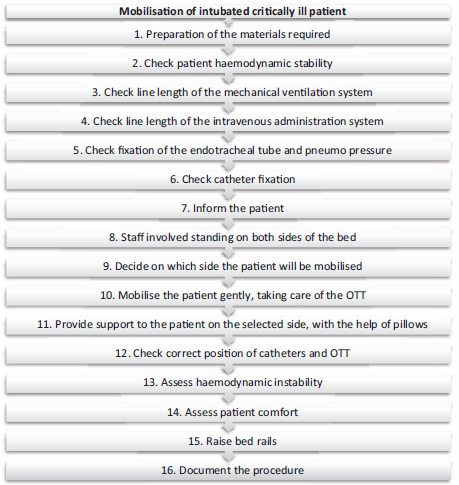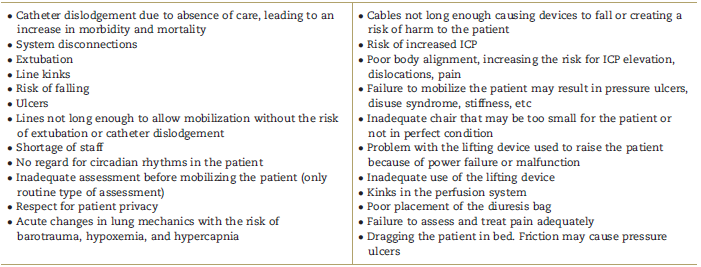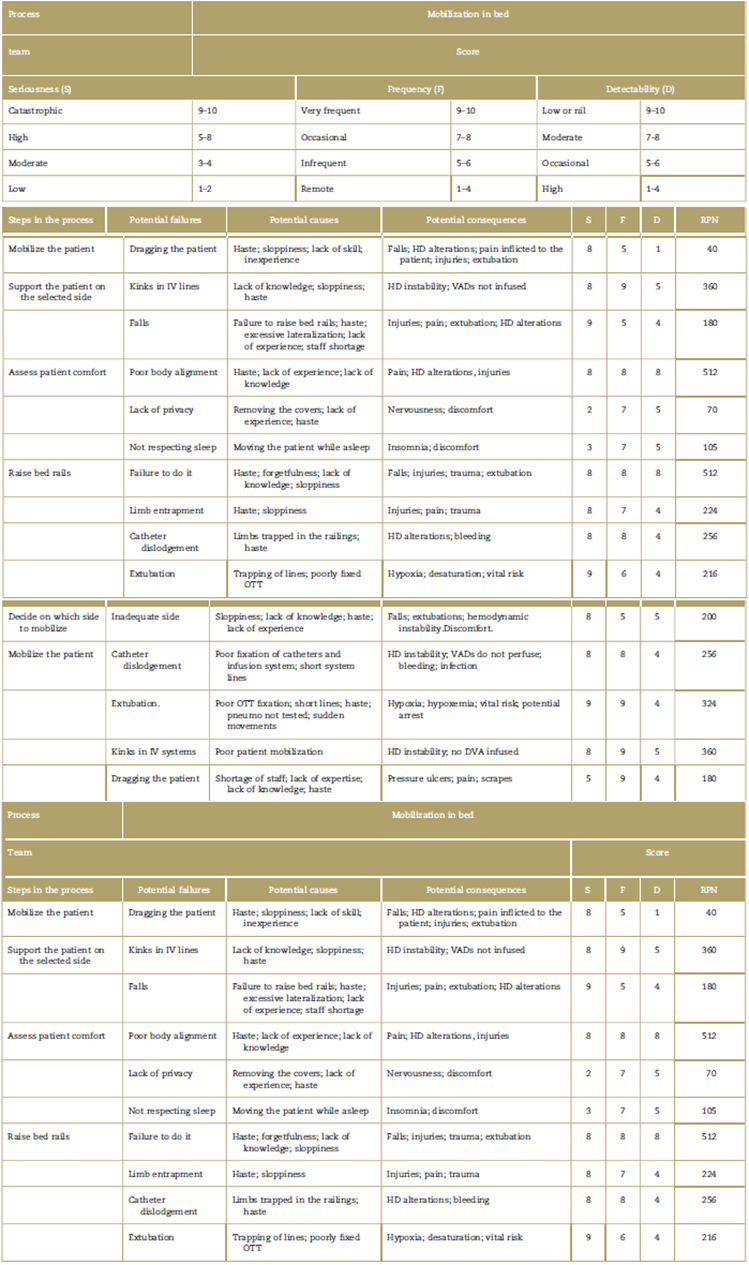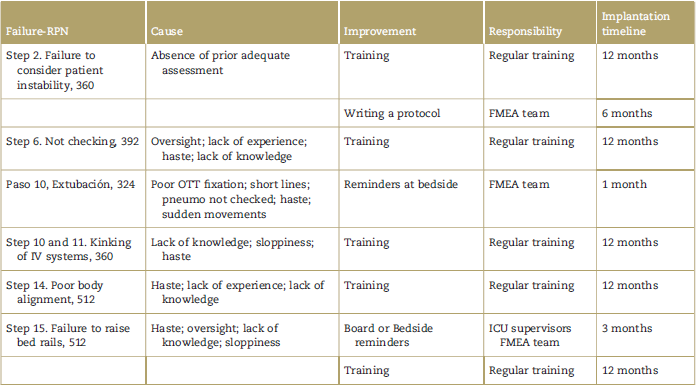Introduction
Patient safety has become a strategic pillar in health care organizations, requiring significant resources with the aim of avoiding accidents during hospital stay. Considering that error is inherent to human nature, its consequences need to be minimized.
Health care may create risks, and patient safety is the most important care quality objective. Nursing care represents one of the biggest risks, particularly in the intensive care unit (ICU), given the complexity of care, procedures, techniques, and technologies. This has been demonstrated in various international1 and national2,3 publications since the late 1990s.
Safety in health care must be enhanced using different tools such as Failure Mode and Effects Analysis (FMEA),4 which, in this paper, will be considered in relation to the mobilization of the intubated patient.
FMEA seeks to solve problems that may arise as part of a process, even before they manifest themselves. It identifies every potential failure in order to assess the severity of potential effects and the frequency of the causes that give rise to them, establishing priority actions with the aim of improving process design. FMEA implementation in the health sector has been slow despite its strong implementation in the industrial arena, particularly in the aerospace field in the United States, where the margin of error is very tight and consequences are very difficult to address. FMEA allows to prioritize potential failures according to risk, probability, and possibility of detection in order to implement improvement actions designed to eliminate or reduce the probability of them happening. For this reason, it is important to identify the weakest links in the health system, where protection is most needed. Moreover, being a preventive method, its study does not require the actual occurrence of errors. 5
FMEA results in improved care quality, early identification and removal of process failures, prioritizing deficiencies, strengthening prevention, guiding control and development improvement, and fostering multi-disciplinary work. In intensive care medicine, FMEA may be of significant use, although few studies have been conducted so far.
Critically ill patients are more prone to develop pressure ulcers due to immobility, disease, old age, long hospital stay, hemodynamic and gas exchange disorders, 6 shearing, friction and medications, nursing care, the environment and patient-related factors. 7 Early mobilization is key in order to avoid ICU-acquired weakness (ICUAW), 8 and it is the best preventive strategy. 9 Postural changes benefit the critically ill patient, preventing the development of pressure ulcers, although mobilization of patients connected to different devices such as endotracheal tubes (ETTs) and central catheters may result in severe consequences. Moreover, there is a need for frequent mobilization.
The health system works hard to ensure patient safety, but errors leading to adverse effects (AEs) continue to occur. 10 An AE is non intentional harm caused by health care actions that results in measurable disability. Synonyms include harmful health effect, adverse consequences, and negative impact. Adverse events cause measurable harm to the patient, while near-misses do not cause harm to the patient but could have resulted in serious consequences had they occurred.
The FMEA tool can now be used to improve safety by means of systematic risk analysis and improvement actions. 11
Method
Hypothesis
The FMEA method can be used to make proposals for improving patient safety in the ICU during the process of mobilization, analyzing potential risks, and proposing systematic improvement actions.
Objective
The overall objective is to "use FMEA for identifying potential failures in the selected process," and the specific objectives are as follows:
To identify the points at which care for the critically ill patient may fail (failure modes) and to enable the necessary means and procedures for detection.
To make the quantitative assessment of each failure mode.
To recommend actions aimed at reducing failure probability in the care process of the critically ill patient for those failures with a Risk Priority Number (RPN) higher than 300. The choice of that number was determined by the complexity of critically ill patients.
The FMEA tool was used in the ICU of the Gregorio Maranon General University Hospital (HGUGM). The design was based on the different phases of the FMEA.
Selection of the team
The team consisted of 4 physicians, 9 registered nurses (RNs), and 3 ICU licensed practical nurses (LPNs). The majority have more than 5 years of experience working in the unit. Three 1-hour meetings were held.
Risk assessment
A brainstorming session was conducted with the ICU staff (physician, RNs, and LPNs), with the aim of gathering information and reaching an agreement regarding potential failures and effects that may occur during the process and give them a numerical score: RPN (Table 2).
We discarded the ones that were not related to patient safety and, for the remaining ones, we asked the following:
(1). Failure: What may go wrong?
(2). Failure modes: How can it fail?
(3). Causes: Why can it fail?
(4). Effects: What may the consequences of the failure be?
(5). Seriousness: What may be the repercussion of the failure for the patient?
(6). Occurrence: What is the probability that the failure may happen?
(7). Probability of detection: What is the probability of detecting it?
Together, seriousness, occurrence, and probability of detection provide the RPN score, which is then used to prioritize improvement actions. Each parameter is scored from 1 to 10 and then multiplied among themselves.
Seriousness may be quantified as
(1). Low (1-2): no consequences resulting in patient injury, no prolonged length of stay, no need to increase surveillance.
(2). Moderate (3-4): prolongs length of stay or requires greater surveillance during a limited period of time.
(3). High (5-8): Results in injury, permanent loss of some function, need for additional treatment, longer length of stay, or need for additional care due to hemodynamic instability.
(4). Catastrophic (9-10): Life-threatening.
Occurrence may be quantified as
(1). Remote (1-2): Improbable, no known event.
(2). Infrequent (3-4): Possible occurrence, some known case over the past 5 years.
(3). Occasional (5-8): Probability of occurrence, several known cases over the past 2 years.
(4). Very frequent (9-10): Probability of it happening right away, several known cases over the past year.
Possibility of detection may be quantified as
Development of FMEA tables
Once everything was analyzed, FMEA tables in the form of results were prepared (Table 3).
Results
The tables show 101 failure modes and we proposed improvement actions for sub processes with RPN values higher than 300. The decision was driven by the complexity of critically ill patients, in order to focus resources on those errors with the highest scores for the quantified parameter. This means they need at least to be highly serious, of occasional occurrence and/ or not amenable to early detection. For example, mechanical ventilation disconnection represents a serious risk for the patient; although it occurs very frequently, failsafe mechanisms such as the ventilator alarms are activated immediately, making it possible to respond quickly and address potential effects, avoiding consequences.
These improvement actions will result in changes to the process or the addition of new barriers in order to avoid the risks identified (Table 4).
RPN values range between 576 and 20; 46 were higher than 300, accounting for 46.46% of the total.
Following our results, 63 improvement actions have been recommended.
Discussion
These results cannot be compared with prior studies because, although FMEA has been applied in other areas of medicine, 13 it has never been applied to the process studied by our group.
Although there are FMEA studies in Spain, 14,15 improvement actions are applied to failures with an RPN above 100. In this study, improvement actions are applied to failures with an RPN greater than 300, given the complexity of the critically ill patient.
Other health care centers with different mobilization protocols might find different failures and quantify them differently, based on their own peculiarities.
RPN scores were found to range between 20 and 576.
SCIENTIFIC ANDSource: Authors.
The highest RPN in our study was 576 and reflects failure to use a basic safety mechanism such as raising bed rails, increasing the risk of falling.
The lowest RPN in our study was 20, reflecting the absence of mechanical devices for mobilizing the patient. This situation poses no risk to the patient, although it does represent a risk for the health care staff in charge of mobilizing the patient.
A large number of the improvement actions proposed in this research are based on training and awareness of the health care staff. Therefore, an adequate "training plan" is imperative in order to address mistaken habits that influence daily practice. This training plan must be part of organizational strategy and highlighted as a safety objective by the committees, units, or task forces charged with patient safety and risk management in health care institutions. Recycling in known techniques will always be welcome as new published knowledge is adopted. Recycling underpinned by good training will create awareness among the senior staff, the population for which change in routine practice is the hardest. Moreover, this training plan should be mandatory for all new staff in a special or new unit, as it would improve the quality of health care, as shown in the study by Alonso Ovies et al. 16
A patient mobilization protocol should be developed by the FMEA team, including requirements for getting the patient out of bed and into bed. The recommendation is to use the available mechanical lifting devices for this job, and at least three RNs or LPNs should participate. Considering that the lifting device as well as its fixtures are critical for this work, it is important to ensure that everything is operational. This requires regular checks by the staff in charge, such as the ICU supervisor or the person responsible for maintenance of all ICU devices. It is also advisable to have a set of batteries to ensure that there is always one being charged, and that the lift will always be operational. Finally, it is important to insist on the measures designed to prevent falls, including bed rails, which need to be in good condition and must be used at all times. In this regard, it is advisable to place signs in the unit to remind the staff. Although intubated patients may be under different levels of sedation, it does not mean that the risk of falling is avoided.
The brainstorming phase is critical in the FMEA model, as it brings a large number of potential failures in health care processes and subprocesses to the surface, things that might not have been considered by the staff otherwise. Different personal perspectives from people with different backgrounds may also be eye-openers for others.
Training in FMEA and a step-wise approach to analyzing routine processes in daily practice will set the basis for developing a "risk map" that will result in safer and more efficient day-to-day practice. Organizations cannot afford to cover the costs associated with unsafe practices at a time in which equity requirements do not allow budget derailing.
Conclusion
The FMEA tool was effective for determining failure modes in the selected process. Also, FMEA allowed to identify errors in the selected process, with a finding of 101 failure modes, 46 of which exceeded a PRN of 300, and have been selected for 63 proposed improvement actions.
Many of the failures result from practices entrenched in custom that need to be changed by means of training and awareness measures, because some techniques may become routine as a result of repetition. Changes in health care staff behaviors are needed in order for FMEA to be effective. They must be made aware of the fact that FMEA offers a new possibility to work in a harm-free environment in the long run.
It is highly advisable to incorporate the FMEA tool into our education plans so that it can eventually be used in the most routine processes of our health care practice.
A new mobilization protocol may be proposed as a result of the analysis of the failure modes. It would be useful to review it and implement it rigorously, providing adequate training to the staff in the unit as well as to other staff that may join the unit in the future.
Ethical disclosures
Protection of human and animal subjects. The authors declare that no experiments were performed on humans or animals for this study.
Confidentiality of data. The authors declare that they have followed the protocols of their work center on the publication of patient data.
Right to privacy and informed consent. The authors declare that no patient data appear in this article.











 text in
text in 






